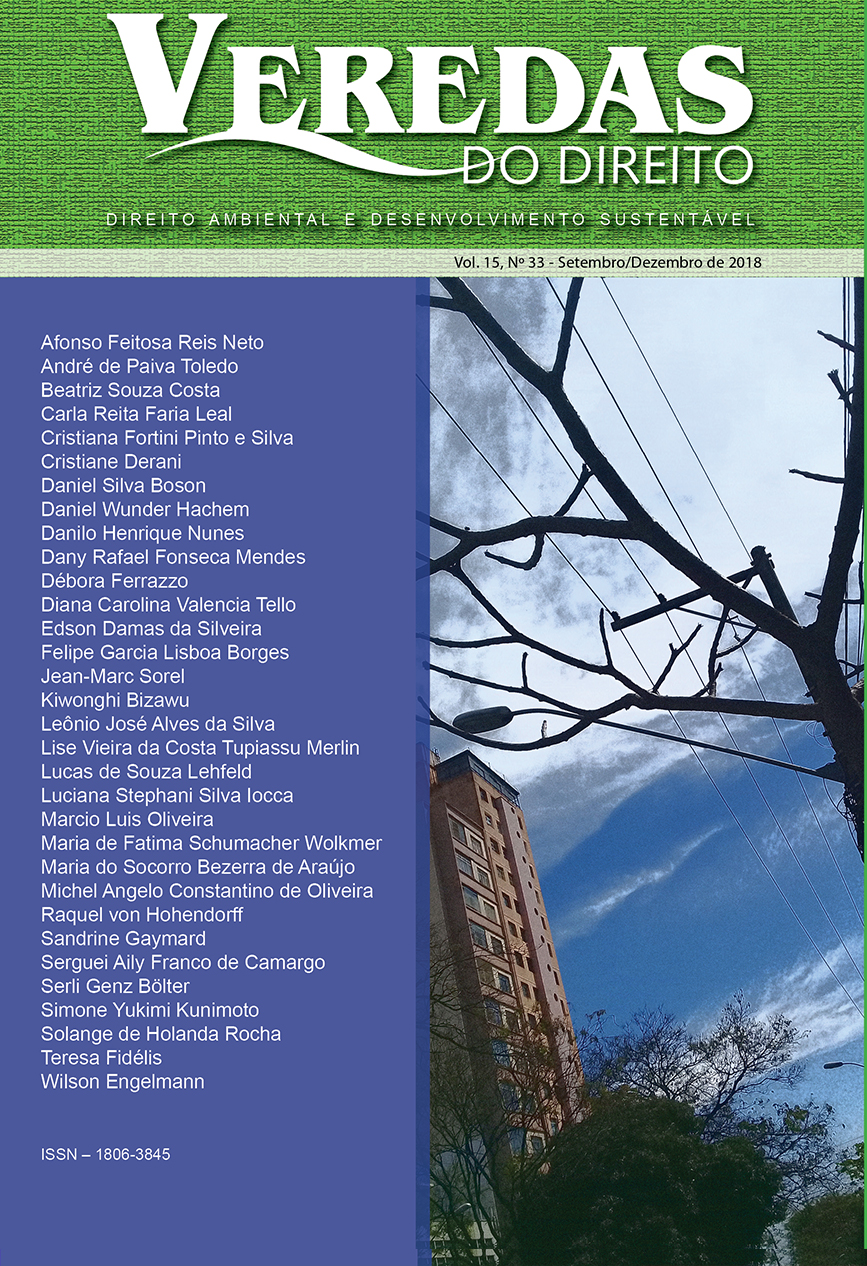THE LEGAL PERCEPTION OF THE RISKS OF NANOTECHNOLOGIES IN THE ENVIRONMENT: CHALLENGES AND POSSIBILITIES IN THE CONSTRUCTION OF A FRAMEWORK
##plugins.themes.bootstrap3.article.main##
Resumo
The use of nanoscale is currently growing. The state legislative regulation on the matter is inexistent. There is the rise of self-regulation, as well as the creation of norms by other social actors. The system of Law needs to enter in the context of innovation, granting legal effects to this regulatory production. The temporality of the new forms of regulation and the ability to deal with future risks and damages represent other challenges for the legal area. The analysis of publications from the OECD and the Web of Science showed that the risk theme is still little discussed in the main scientific journals. From these findings, we present a framework as an regulatory alternative and guideline for the industry that develops products from nanotechnology. Investments in research, categorization and risk analysis throughout the product life cycle is a necessary requirement to guide the governance, the regulation and the self-regulation of the issue.
##plugins.themes.bootstrap3.article.details##
Submeto (emos) o presente trabalho, texto original e inédito, de minha (nossa) autoria, à avaliação de Veredas do Direito - Revista de Direito, e concordo (amos) que os direitos autorais a ele referentes se tornem propriedade exclusiva da Revista Veredas, sendo vedada qualquer reprodução total ou parcial, em qualquer outra parte ou outro meio de divulgação impresso ou eletrônico, dissociado de Veredas do Direito, sem que a necessária e prévia autorização seja solicitada por escrito e obtida junto ao Editor-gerente. Declaro (amos) ainda que não existe conflito de interesse entre o tema abordado, o (s) autor (es) e empresas, instituições ou indivíduos.
Reconheço (Reconhecemos) ainda que Veredas está licenciada sob uma LICENÇA CREATIVE COMMONS:
Licença Creative Commons Attribution 3.0Referências
Azoulay, D., Buonsante, V. (2014). œRegulation of nanomaterials in the US: Proposed measures to fill in the gap. European Journal of Risk Regulation 2: 228-235. doi: https://doi.org/10.1017/S1867299X00003652.
Bardin, L. (2013). L'Analyse De Contenu. 2e Édition. Paris: PUF.
Beck, U. (2006). œLiving in the world risk society. A Hobhouse Memorial Public Lecture given on Wednesday 15 February 2006 at the London School of economics. Economy and Society 35 (3): 329-45. doi: http://dx.doi.org/10.1080/03085140600844902.
Beck, U. (1992). Risk Society: towards a new modernity (Published in association with Theory, Culture & Society). London: SAGE Publications.
Brazil. (2017). Law n. 12,305, of August 2, 2010. Retrieved May 18, 2017, from http://www.planalto.gov.br/ccivil_03/_ato2007-2010/2010/lei/l12305.htm.
Foladori, G., Invernizzi, N. (2016). œLa Regulación de las Nanotechnologies: una mirada desde las diferencias EUA-UE. Vigil. Sanit. Debate. 4 (2): 8-20. doi: 10.3395 / 2317-269x.00726.
Gatti, A. M., Montanari, S. (2008). Nanopathology. The health impact of nanoparticles. Singapore: Pan Stanford.
Gonçalves, V. (2013). œCritical approach of the use of economic models in precautionary risk management. European Journal of Risk Regulation 3: 335-45. Retrieved May 18, 2017, from http://ejrr.lexxion.eu/article/EJRR/2013/3/286.
He, X., Hwang, H.-M. (2016). œNanotechnology in food science: functionality, applicability, and safety assessment. Journal of Food and Drug Analysis, 24 (4): 671-81. Retrieved May 18, 2017, from http://www.jfda-online.com/article/S1021-9498(16)30075-8/pdf.
Hischier, R.; Walser, T. (2012). œLife cycle assessment of engineered nanomaterials: state of the art and strategies to Overcome existing gaps. Science of Total Environment 425: 271-82. doi: 10.1016 / j.scitotenv.2012.03.001.
Interdisciplinarity. (2015). Nature 525: 325. Retrieved May 18, 2017, from http://www.nature.com/news/interdisciplinarity-1.18295.
ISO/TC 229. (2017). Retrieved May 18, 2017, from http://www.iso.org/iso/iso_technical_committee?commid=381983.
Kahru, A., Ivask, T. H. E. (2013). œMapping the Dawn of Nanoecotoxicological Research. ACC Chem. Res 46 (3): 823-33. doi: 10.1021/ar3000212.
Krug, H. F. (2014). œNanosafety Research-Are We on the Right Track? Angewandte Chemie International Edition 53: 12304-319. doi: 10.1002/anie.201403367.
Luhmann, N. (1990). Sociedad y sistema: la ambición de la teoría. Barcelona: Paidós.
Maynard, A. D. (2011). œDo not define nanomaterials. Nature, 475: 31. Retrieved May 18, 2017, from http://www.nature.com/nature/journal/v475/n7354/full/475031a.html.
NanoAction. (2007). œPrinciples for the Oversight of Nanotechnologies and Nanomaterials. Retrieved May 18, 2017, from http://www.centerforfoodsafety.org/files/final-pdf-principles-for-oversight-of-nanotechnologies_80684.pdf.
OECD. (2017). œWorking Party on Nanotechnology (WPN): Vision Statement. Retrieved May 18, 2017, from https://www.oecd.org/sti/nano/oecdworkingpartyonnanotechnologywpnvisionstatement.htm.
Owen, D. (2011). The Conundrum: How Scientific Innovation, Increased Efficiency, and Good Intentions Can Make Our Energy and Climate Problems Worse. New York: Penguin Group.
Park, H.-G., Yeo, M.-K. (2016). œNanomaterial regulatory policy for human health and environment. Mol Toxicol. 12: 223-36. doi: 10.1007/s13273-016-0027-9.
Rodine-Hardy, K. (2016). œNanotechnology and Global Environmental Politics: Transatlantic Divergence. Global Evironmental Politics 16 (3): 89-105. doi: 10.1162/ GLEP_a_00367.
Santhosh, C., Velmurugan, V., Jacob, G., Bhatnagar, A. (2016). œRole of nanomaterials in water treatment applications: a review. Chemical Engineering Journal 306: 1116“1137. doi: http://dx.doi.org/10.1016/j.cej.2016.08.053.
Shatkin, J. A., Kim, B. (2015). œCellulose nanomaterials: life cycle risk assessment, and environmental health and safety roadmap Environ. Sci .: Nano, 2: 477-99. doi: 10.1039/C5EN00059A.
Schwab, K. (2016). The Fourth Industrial Revolution. São Paulo: Edipro.
Stone, V. et al. (2017). œResearch priorities relevant to development or updating of nano-relevant regulations and guidelines. Retrieved May 18, 2017, from http://www.safenano.org/news/news-articles/eu-nanosafety-cluster-publishes-research-regulatory-roadmap.
Stone, V. et al. (2016). œResearch priorities relevant to development or updating of nano-relevant regulations and guidelines. Retrieved May 18, 2017, from http://jusnano.blogspot.com.br/2017/01/research-priorities-relevant-to.html.
Ulijn, R. V., Riedo, E. (2016). œLearning to 'think systems'. Nat. Nanotech 11: 824. Retrieved May 18, 2017, from http://www.nature.com/nnano/journal/v11/n9/full/nnano.2016.161.html.
Uniform Description System for Materials on the Nanoscale. (2016). Prepared by the CODATA-VAMAS Working Group On the Description of Nanomaterials, Version 2.0 25 May 2016. Retrieved May 18, 2017, from http://www.codata.org/nanomaterials.
Vaseashta, A. (2015). Life Cycle Analysis of Nanoparticles: risk, assessment, and sustainability. Lancaster, USA: DEStech Publications.
Wackera, M. G., Proykova, A. and Santos, G. M. L. (2016). œDealing with Nanosafety around the globe-Regulation vs. Innovation. International Journal of Pharmaceutics 509: 95-106. doi: http://dx.doi.org/10.1016/j.ijpharm.2016.05.015.
Warheit, D. B. (2010). œDebunking Some Misconceptions about Nanotoxicology. Nano Lett 10 (12): 4777-82. doi: 10.1021/nl103432w.
Xiangang, H., Dandan L., Gao Y. and Zhou, Q. (2016). œKnowledge gaps between nanotoxicological research and nanomaterial safety. Environment International 94: 8-23. doi: http://dx.doi.org/10.1016/j.envint.2016.05.001.



































